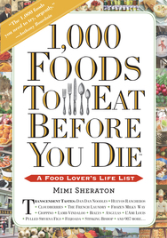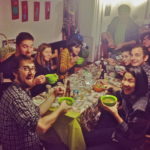There are few things in life better than a good old-fashioned burger—but what are the origins of this quintessential American food? Celebrate National Hamburger Day (or any day really) by exploring the history of the hamburger and tips for cooking up the perfect one every time with Mimi Sheraton, author of 1,000 Foods to Eat Before You Die.
Impatient, on-the-run Americans love the convenience of hand-held food. Fittingly, two quintessential American foods are German émigrés becoming U.S. citizens only after being stuffed into rolls. Named for the city of Frankfurt, the frankfurter turned into the hot dog, while the classic Deutsches beefsteak evolved into the hamburger, so named because so many German immigrants hailed from the rainy North Sea port of Hamburg. (Truth be told, sausages with buns have long been popular in Frankfurt, but it took an overseas trip for them to be commoditized as the classic food of streets and sports venues.)
becoming U.S. citizens only after being stuffed into rolls. Named for the city of Frankfurt, the frankfurter turned into the hot dog, while the classic Deutsches beefsteak evolved into the hamburger, so named because so many German immigrants hailed from the rainy North Sea port of Hamburg. (Truth be told, sausages with buns have long been popular in Frankfurt, but it took an overseas trip for them to be commoditized as the classic food of streets and sports venues.)
The original Deutsches beefsteak is exactly what old-time menus in the U.S. listed as chopped or Salisbury steak: a knife-and-fork main course of pan-grilled ground sirloin topped with sautéed onions and pan drippings that created a mild, soft sauce. Just who first sandwiched the meat cake into a bun is open to question. Food historian Giovanni Ballarini offers the prevailing version of the story: Toward the end of the nineteenth century, soon-to-be American immigrants aboard ships were handed grilled meat patties between two slices of bread. (No plates, no water wasted in washing.) But in her famous 1747 English recipe book The Art of Cookery, Made Plain and Easy, Hannah Glasse refers to Hamburg “sausage,” a chopped combination of beef, suet, and spices that she suggested be served with toast.
Or was the first really Charlie Nagreen, a fifteen-year-old who sold meatballs at a country fair in Seymour, Wisconsin, in 1885? Legend has it that he decided he could sell more meatballs if he put them between bread so customers could eat them out of hand while taking in the fair’s attractions. And how about Louis Lassen, who in 1900 had a lunch wagon in New Haven, Connecticut, where he sandwiched cooked scraps of beef between slices of bread? The wagon eventually became a shop, and Louis’ Lunch sells hamburgers to this day.
In truth, history is beside the point when one bites into a richly beefy, succulently juicy burger, dripping from chin to napkin if not to shirtfront. Perfectly seared to a thin, savory crust (never charred to bitterness), and ideally cooked medium-rare—blood-crimson and a bit warm in the center—the burger is best encased in a fresh, lightly toasted and yeasty bun, sturdy enough to stay intact after absorbing drippings yet soft enough to be bitten into easily. The current fashion for hard-crusted rolls such as ciabatta and sourdough is a thoroughly nonfunctional design.
What goes between beef and bread? For purists that would be a paper-thin slice of sweet, raw onion and a light smear of Heinz ketchup. Dijon mustard is a permissible alternative, but mayonnaise, Russian dressing, ranch-style dressing, sweet pickle relish, and so on, need not apply—nor should a frilly garden of salad greens and tomatoes that turn the meat cold. Cheese and bacon? Maybe, but not for those who value beef for its own sake. If there is to be cheese, it should be the subtly melting, mildly pungent type—real Cheddar, mozzarella, or Gruyère, not waxy, processed American cheese. Moldy or musty cheeses—the blues and those made with goat’s or sheep’s milk—lend a spoiled, fetid flavor.
The best hamburgers come from cuts of beef with some fat and texture, with chuck being an all-around good choice. For more flavor and body and slightly less fat, a half-and-half combination of chuck and sirloin, ground together so they are thoroughly blended, is the best choice. A small amount of brisket or some ground beef kidneys can be added to chuck, but round steak is to be avoided, as it tends to cook dry and tough. The late James Beard, the grand pooh-bah of American cuisine, liked to mix a touch of heavy sweet cream or diced bone marrow into the meat for extra richness, while the master of hamburger magic, Daniel Boulud, fills the center of his burger with scrumptious scraps of gently braised short rib, and, for good measure, a nice fat hunk of foie gras—a sublime (if pricey) treat.
In truth, good beef needs very little seasoning. Just a dash of salt and pepper does the trick, although some add a bit of grated onion or crushed garlic and a sprinkling of a favorite herb, such as thyme, oregano, or chopped chives. The mixing should be done lightly, with a fork. Charcoal broiling will always be a favorite cooking method in the U.S., but for a more subtle result, sprinkle a heavy, black, cast-iron skillet with coarse salt, heat it up, and place the hamburgers in it, allowing at least an inch and a half of space between them so they do not steam. When the first side is seared and is easily loosened from the pan (after seven to eight minutes), add a touch of coarse salt to the raw side, flip it over, and fry for another six or seven minutes, or until blood rises to the surface when you press gently on the top of the burger with your finger. The salt will caramelize and burnish the beef’s flavor.
Do not pat burgers down while they are frying, and try not to turn them more than once. For extra deliciousness, smear a dot of sweet butter on top just as you remove the burgers from the pan. Because it creates enormous clouds of smoke, this kind of pan-grilling should be done only in a well-ventilated cooking area.
Excerpted from 1,000 Foods to Eat Before You Die.
More About 1,000 Foods to Eat Before You Die:
 1,000 Foods fully delivers on the promise of its title, selecting from the best cuisines around the world (French, Italian, Chinese, of course, but also Senegalese, Lebanese, Mongolian, Peruvian, and many more)—the tastes, ingredients, dishes, and restaurants that every reader should experience and dream about, whether it’s dinner at Chicago’s Alinea or the perfect empanada. In more than 1,000 pages and over 550 full-color photographs, it celebrates haute and snack, comforting and exotic, hyper-local and the universally enjoyed: a Tuscan plate of Fritto Misto. Saffron Buns for breakfast in downtown Stockholm. Bird’s Nest Soup. A frozen Milky Way. Black truffles from Le Périgord.
1,000 Foods fully delivers on the promise of its title, selecting from the best cuisines around the world (French, Italian, Chinese, of course, but also Senegalese, Lebanese, Mongolian, Peruvian, and many more)—the tastes, ingredients, dishes, and restaurants that every reader should experience and dream about, whether it’s dinner at Chicago’s Alinea or the perfect empanada. In more than 1,000 pages and over 550 full-color photographs, it celebrates haute and snack, comforting and exotic, hyper-local and the universally enjoyed: a Tuscan plate of Fritto Misto. Saffron Buns for breakfast in downtown Stockholm. Bird’s Nest Soup. A frozen Milky Way. Black truffles from Le Périgord.
Buy the Book
Amazon | B&N | Indiebound | Workman



No Comments